Home »
Isuzu UK has unveiled its latest creation, the D-Max Mudmaster, a rugged off-road variant of its Isuzu D-Max pick-up.
Built on the top-of-the-range V-Cross trim, the Mudmaster has had almost the entirety of the Isuzu D-Max accessories range thrown at it to help make it the most off-road capable D-Max to date. Think of it as a Ford Ranger Raptor with all the options Isuzu could find.
Changes over the standard model include include a snorkel for deep water wading, a powerful winch for self-recovery, a lifted suspension for increased ground clearance, and a protective steel underbody shield. There's also high-intensity lights and a roof rack.
The D-Max Mudmaster is the latest in a long line of pimped-up pick-ups from the Japanese manufacturer. The most recent model was a concept version from Arctic Trucks. The wild looking D-Max AT37 concept got larger wheels and tyres with flared wheelarches, as well as powerful front spotlights and a winch.
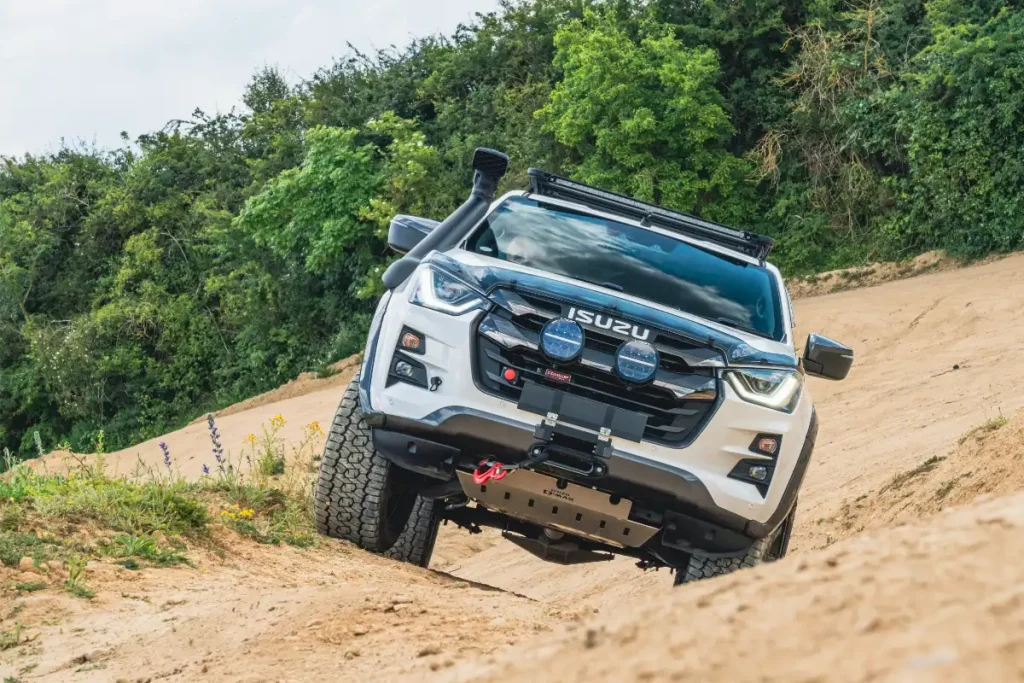
Isuzu D-Max Mudmaster enhancements:
Custom Design Elements: Including a white Isuzu badge and Mudmaster decals, adding a unique and distinctive look to the vehicle.
ARB Safari Snorkel: Elevated air intake for optimal airflow during water wading, ensuring the engine receives clean air even in deep water conditions.
COMEUP Winch: Hidden behind the front bumper, allowing for self-recovery or assisting others in off-road scenarios. The lift-up metal registration plate provides easy winch access without obstructing the vehicle’s aesthetics.
PEDDERS Off-Road Suspension Kit: Provides a 1.75” vehicle lift, significantly increasing ground clearance to navigate over rocks, logs, and other obstacles with ease.
ARB Base Rack: Mounted on the cabin for essential off-road accessories like tyre recovery pads, extra fuel cans, tow straps, or a shovel, enhancing the vehicle’s utility and preparedness for any adventure.
Plastic Under-Rail Liner: Mounted in the load bed, covered by an Alpha XS Top canopy, for maximum cargo space on expeditions or overlanding trips, protecting the bed from damage and securing cargo.
20” Hurricane Alloy Wheels: In grey colour, offering both style and durability to handle rugged terrains.
Toyo Open Country A/T III All Terrain Off-Road Tyres: Ensure superior traction and stability on various off-road surfaces, and enhance safety and performance, while maintaining road comfort.
Lazer Sentinel 7” Elite Rally-Style Lamps: Fitted on the grille to provide powerful illumination in low-light conditions, improving visibility and safety.
Lazer Linear-36 Elite Lightbar: Mounted on the roof for ultimate brightness, bringing daylight to the darkest areas and ensuring excellent visibility during night-time expeditions.
Steel Underguard Protection: Covering all drivetrain elements to protect against damage from uneven terrains and obstacles underneath the vehicle.
Wind Visors: Reducing wind noise and allowing for ventilation even during light rain, enhancing driving comfort.
Bonnet Protector: Safeguarding the bonnet from debris and stone chips, maintaining the vehicle’s appearance.
Door Handle Protectors: Preventing scratches and wear on frequently used areas, preserving the vehicle’s finish.
Lifted Off-Road Side Steps: Providing easier access to the vehicle’s cabin and adding an extra layer of protection to the side panels. The lifted profile also maintains the vehicle clearance.
Interior Rubber Mats: Offering easy-to-clean, durable protection for the vehicle’s interior from mud, dirt, and water.
Heavy Duty Seat Covers: Protecting the seats from wear and tear, ensuring the interior remains in top condition.
Illuminated Door Sills: Adding a touch of style while making it easier to enter and exit the vehicle in low light conditions.
Tow Bar with 13-Pin Electrics: Enabling the Mudmaster to tow trailers with full electrical functionality, enhancing its utility.
Cladding Kit: Providing extra protection to the vehicle’s body, preventing damage from debris and enhancing its rugged appearance.
Fender Lips: Expanding the wheel arches to accommodate larger tyres and providing additional protection from mud and debris.
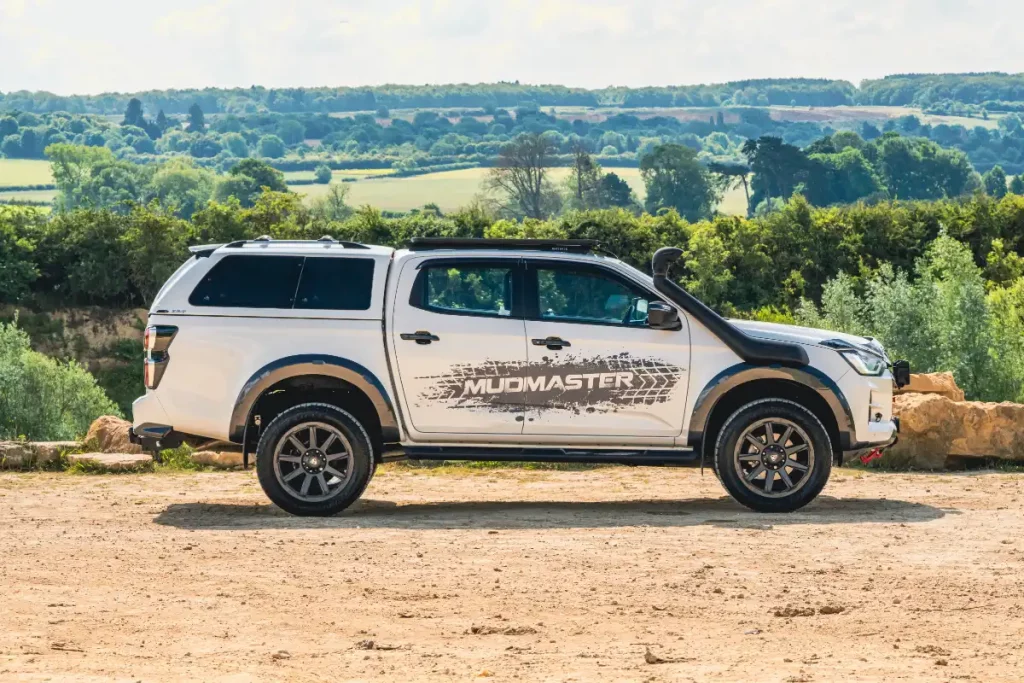
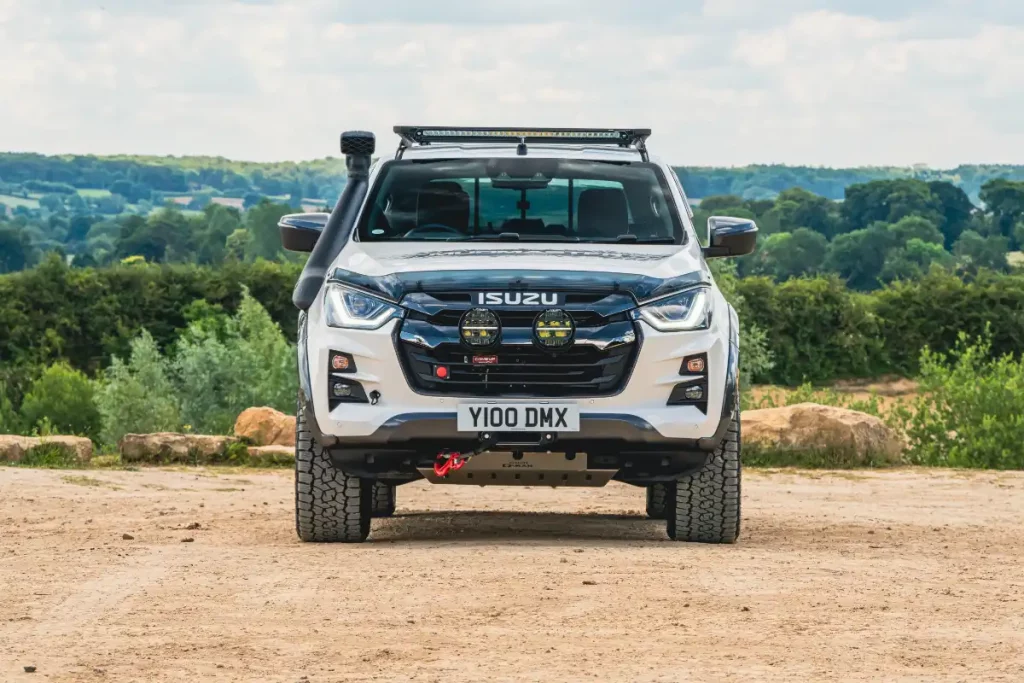
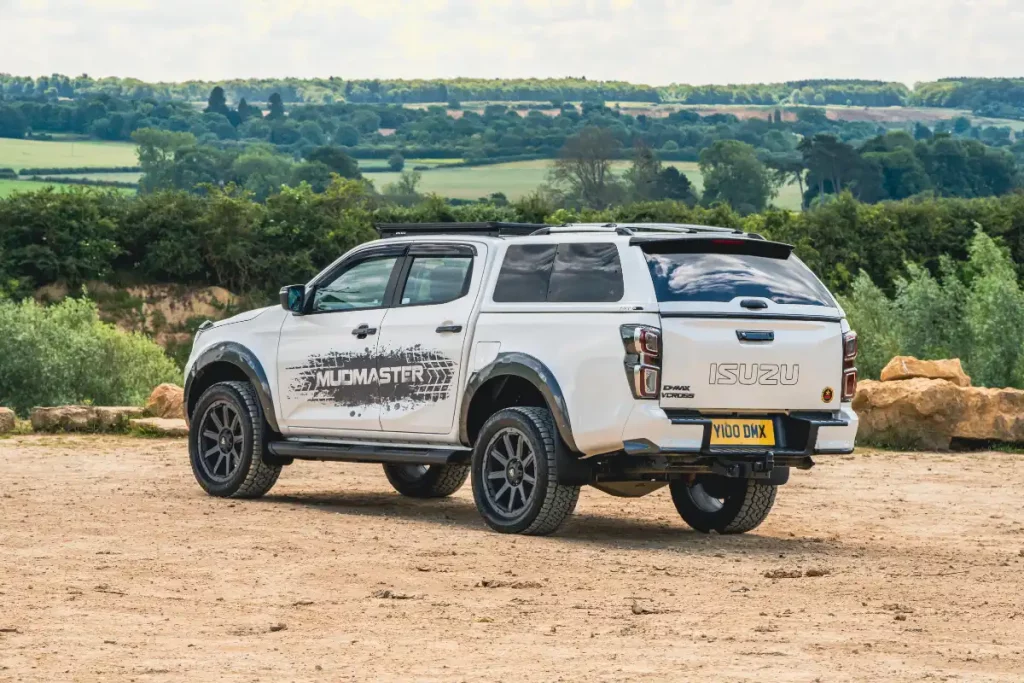
Becuase the Isuzu D-Max Mudmaster is based on the highest specification D-Max V-Cross model it will come at a premium price. It's available in two versions with either a 6-speed manual or 6-speed automatic gearbox. Currently the V-Cross is available to buy from £36,495 for the manual gearbox and £38,495 for automatic transmission.
Production of commercial vehicles in the UK declined by 2.9% in the first half of the year, according to the latest data from the Society of Motor Manufacturers and Traders (SMMT).
A total of 56,956 vans, trucks, taxis, buses and coaches rolled off production lines between January and June, compared to the same period in 2023.
The SMMT attributed the decrease to a slowdown following a strong performance last year as the automotive industry recovered from the pandemic.
Despite the decline, overall production remains significantly higher than pre-pandemic levels, driven by increased export demand and investment in new models and technologies.
Overseas shipments of UK-built commercial vehicles rose by 3.6% to 39,168 units in the first half of the year, with the European Union accounting for the majority of exports.
However, the domestic market contracted by 14.8% over the same period.
Mike Hawes, SMMT Chief Executive, said, “While a decline in output is always disappointing, some normalisation following the CV sector’s rapid post-pandemic recovery was expected. The sector remains in good health with strong global demand for high quality British-built CVs and plants ramping up EV production to meet current and future needs. However, the sector will not rest on its laurels and will work with the new government to deliver the favourable industrial, trade and market conditions that are essential if manufacturers are to drive economic growth and decarbonisation in every part of the country.”
Industry forecasts predict a gradual increase in commercial vehicle production in the coming years, with the potential to exceed 130,000 units by 2030.
Recent figures, also released by the SMMT, show that For continues to lead the way for van registrations with the Ford Transit Custom maintaining its position as the most popular van on sale in Britain today. Ford also occupies second position with the Ford Transit large van and the Ford Ranger pick-up truck the third most popular commerical vehicle on British roads.
The year-to-date market figures also show that registrations of new BEV vans is down 0.5% compared to last year. So far registrations are at 4.7%, compared to 5.2% last year.
We've all seen the stickers... "no tools left in this vehicle overnight" but it turns out that for a lot of tradespeople that's really not the case.
A surprising number of van drivers are in fact leaving their precious tools in their vans overnight.
That's despite 1 in 5 UK businesses falling victim to crime from their vans last year. According to research from Volkswagen Commercial Vehicles, 19% of van drivers had their vans broken into and tools stolen.
Year-on-year, crime from vans is down but a Freedom of Information request revealed that 15,464 individual cases were reported to police.
Read our guide on how to keep your van safe from tool theft and van theives
Understandably a lot is at stake for a business, but there's a lot to gain for the criminals too. The average value of stolen equipment per van stands at over £1,700. Multiply that out and that could mean that UK tradespeople are facing a bill of up to £1.64 billion in stolen gear.
Worse still is that more than a third (37%) of van owners say that they leave tools in their vans with a value of more than £2,000.
A majority (57%) of tradespeople surveyed reported being unable to work entirely while their vans are restocked with tools and repairs are made after a break-in.
That downtime costs an estimated £550 a day per van, and there's also a high probability of an increase in future insurance premiums after such a loss.
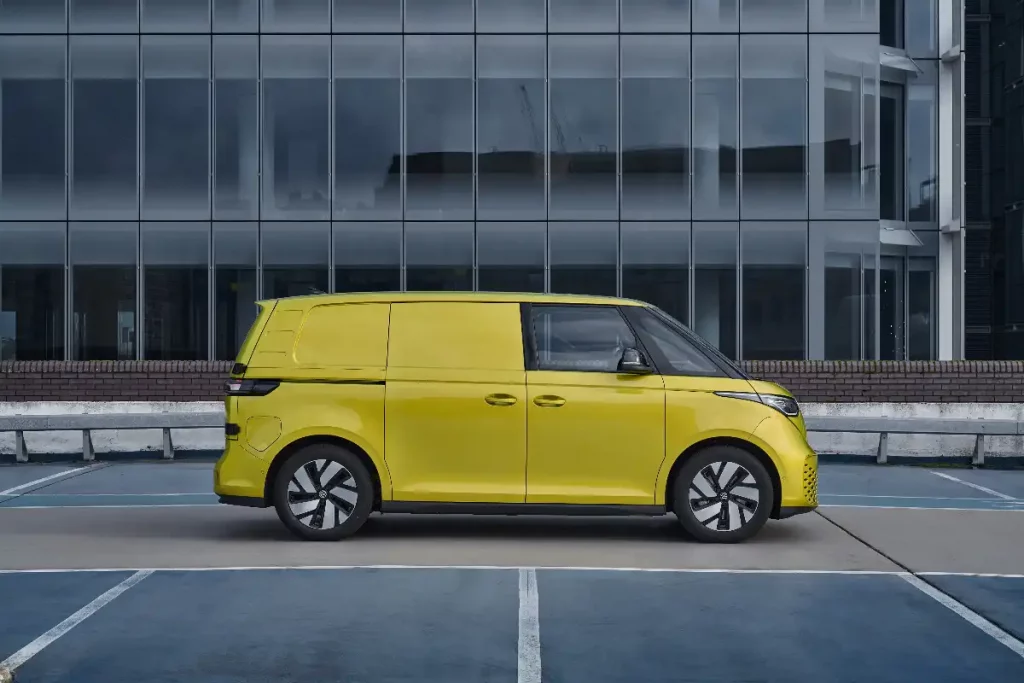
John Ricardo-Neto, head of product planning at Volkswagen Commercial Vehicles, said: “The cost of theft is more than just the price of the tools stolen, it’s the downtime while van drivers replace the stolen equipment, the higher insurance premiums and lost revenues, so it’s imperative that UK tradespeople be vigilant to tool theft.
“We urge those who own expensive equipment to take extra precautions – securing or removing tools overnight and parking in a well-lit, CCTV-monitored area. For those who wish to further increase the security of their vehicles, our range of theft prevention technologies can offer extra protection, allowing van drivers to get back to focusing on their businesses.”
In an effort to remind van drivers about the risks, VW says that its Volkswagen ID Buzz Cargo comes fitted with an anti-theft alarm system as standard. When activated, the anti-theft alarm system sounds the horn and activates the hazard lights to help alert the break-in.
Orders are now open for the Renault Trafic E-Tech, the medium-sized electric van, with prices starting from £34,500 plus VAT (after the government's Plug-in Van Grant). First deliveries are expected in September 2024, giving businesses a zero-emission option for their fleets.
See our list of the best medium electric vans
The Trafic E-Tech comes in three body styles, including a high-roof version that provides additional cargo space. It joins Renault's existing electric van range, offering a suitable electric option for businesses of all sizes.
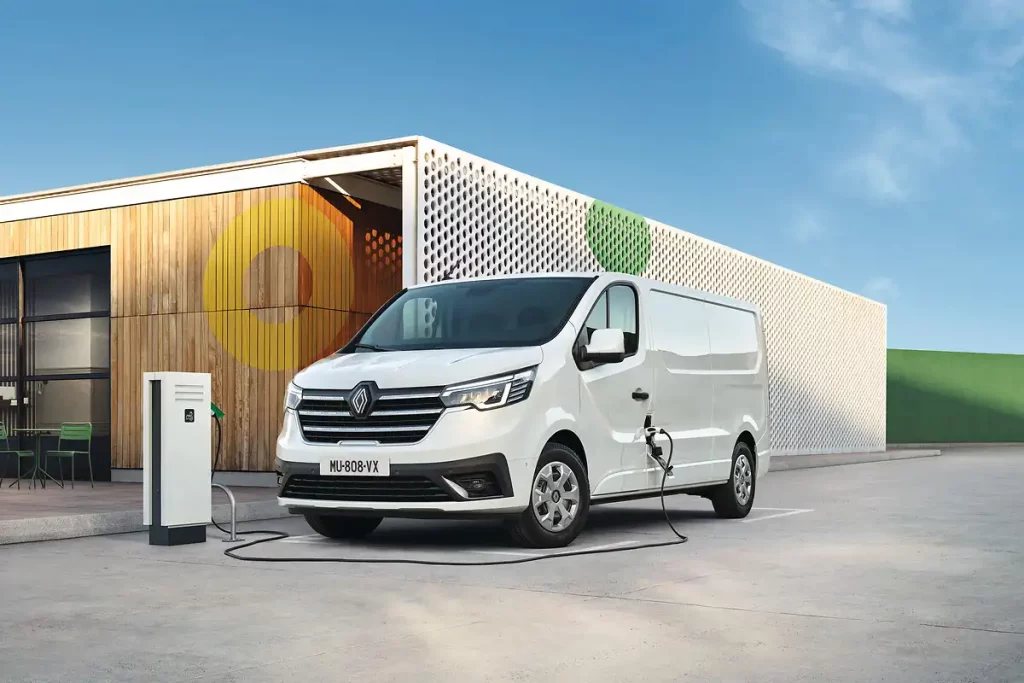
The new electric Trafic offers two body lengths and two roof heights, providing a cargo capacity range of 5.8 cubic metres to 8.9 cubic metres.
The long-wheelbase version can accommodate loads up to 4.15m long and a maximum payload of 1222kg. The Renault Trafic E-Tech also have a towing capacity of up to 920kg.
Inside the cabin, there's up to 88-litres of storage space with a "mobile office" feature that provides a dedicated workspace within the van.
With a 52kWh battery, the Trafic E-Tech has a WLTP-rated driving range of up to 186 miles on a single charge. The battery can be fast-charged using a 50kW DC charger, which can charge the battery from empty to full in around an hour.
The Trafic E-Tech comes with an 8-inch touchscreen infotainment system with smartphone compatibility at standard, as well as LED headlights, electric mirrors, parking sensors, cruise control, and numerous other safety features.
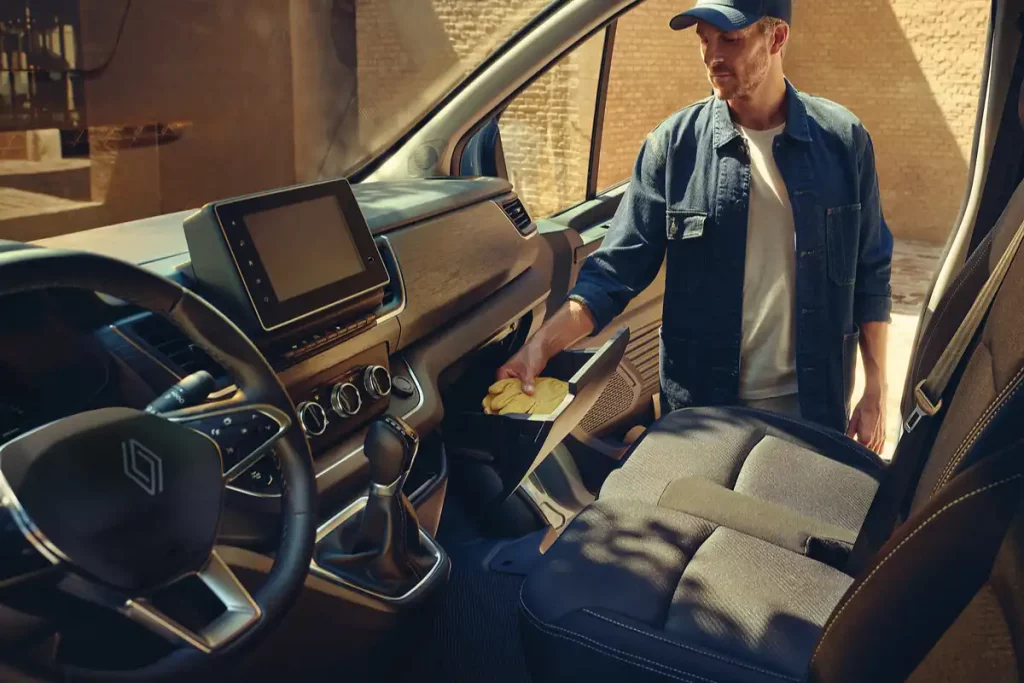
There's also a height-adjustable driver's seat and air conditioningm while options include climate control, heated seats, a 360-degree parking camera, and various other advanced driver assistance systems.
| MODEL | BASIC PRICE | VAT | RETAIL PRICE | PiVG | BASIC PRICE AFTER PiVG | RETAIL AFTER PiVG | OTR CHARGES | OTR AFTER PiVG |
| SL30 E-Tech Advance | £39,500 | £7,900 | £47,000 | £5,000 | £34,500 | £42,400 | £755 | £43,155 |
| LL30 E-Tech Advance | £40,250 | £8,050 | £48,300 | £5,000 | £35,250 | £43,300 | £755 | £44,055 |
| LH30 E-Tech Advance | £41,250 | £8,250 | £49,500 | £5,000 | £36,250 | £44,500 | £755 | £45,255 |
Mercedes-Benz dealership group Intercounty Truck & Van has announced a £2m investment in a new service and parts centre located in Dunstable, Bedfordshire.
The new facility boasts a modern workshop designed to service and maintain Mercedes-Benz vans as well as those of all other makes and is expected to create 30 new jobs in the local area.
Customers will also have access to a parts counter and a range of electric vehicle (EV) support features, including eight dedicated EV charging points.
Located on the Woodside Industrial Estate, it's close to the M1 motorway (J11 and 11a) as well as London Luton Airport. The center aims to minimise downtime for van operators and disruptions in the local area with swift assistance for its customers.
The investment extends beyond the physical facility with Intercounty Truck & Van recruiting apprentices and providing comprehensive training programs for technicians.
The training program is said to exceed industry standards by allowing technicians to specialise in servicing electric vehicle components, including batteries for the new Mercedes-Benz eSprinter.
Nick Skillman, MD at Intercounty Truck & Van, said: “The launch of our new Dunstable site offers incredible opportunity, both for us as a business and for the local economy – particularly as we welcome the transition to electric.
“We’ve been operating as a Mercedes-Benz franchise for over 20 years, covering Northamptonshire, Cambridgeshire, Buckinghamshire and Lincolnshire.
“Now, we have a new, state-of-the-art dealership with huge market potential that sits in a prime location in Bedfordshire – a stone's throw from the M1 and around the corner from our customers at Luton Airport, which is set to double in capacity over the next 20 years.
“The new dealership has been built to meet the demands of loyal customers in the area as well as an engaged local community that is committed to being more sustainable – and we couldn’t be more excited for its launch.”
Simon Neill, customer operations director at Mercedes-Benz Vans in the UK, said: “Intercounty Truck & Van has been a trusted partner of Mercedes-Benz Vans for over 20 years and we are delighted to support the launch of this new, exciting Customer Service and Parts location.
“It is set to provide customers and those travelling up and down the M1 with a huge range of services, parts, electric vehicle expertise and roadside assistance cover to ensure that the Intercounty team continue to keep businesses moving with reliable and sustainable transport.
“We’re also incredibly pleased to see Intercounty Truck & Van investing in 30 more roles that will bring new talent and skill sets to the Mercedes-Benz Vans brand network.”
Peugeot has introduced a new automatic gearbox option for the Peugeot Boxer large van.
The new EAT8 eight-speed automatic transmission is available alongside the six-speed manual gearbox on the 2.2-litre BlueHDi 140 and 180 engine versions of the Boxer.
Buyers can have the option of a Light Duty (Euro 6E) and Heavy Duty (Euro VIE) homologation engine with the new transmission, enable the heavier conversions like motorhomes to be based on the Boxer chassis with a new automatic transmission.
Engines with the EAT8 transmission also get up to 450Nm of torque with the BlueHDi 180 engine which his 80Nm more than the previous manual transmission.
As a result, the Boxer is said to have best-in-class torque in the sector.
Another innovation of the EAT8 automatic transmission is a hydraulic accumulator, which makes it possible to leverage the most from the engine's power by reducing the gearbox response time and promoting the smoother operation of the Start & Stop system.
The overall gross vehicle weight of the Boxer has also been increased to allow for heavier conversions with a new GVW of up to five tonnes.
The Peugeot Boxer is based on the shared Stellantis van platform used by the Vauxhall Movano, Citroen Relay and Fiat Ducato – it’s also sold as the Toyota Proace Max – and is available in two wheelbases (3.45m and 4.04m) with panel vans in two lengths (L2 and L4) and two roof heights giving a load volume of between 13-17m3.
For more on the size of the large Peugeot van read our guide to the Peugeot Boxer dimensions.
The long-wheelbase Boxer is also available as a single cab L3 or L4 chassis, and a double cab L3 or L4 chassis.
Recent changes to the Peugeot Boxer have seen new exterior styling changes that have improved aerodynamic efficiency. The Boxer has gained a new front bumper, grille and mirrors, while on the inside there’s been an overhaul of the cabin along with new driver assistance systems.
Safety equipment now includes an electric parking brake, keyless entry and start, 10-inch central touchscreen, wireless smartphone charging, driver fatigue alert, and automatic emergency braking with pedestrian and cyclist detection.
We’re pretty sure having a van in this condition is a sure-fire way of getting yourself pulled over by Old Bill, but some innovative vehicle wrappers have pulled out all the strops with a “Rusty” Volkswagen Caddy at the National Association of Police Fleet Managers’ Conference (NAPFM).
Earlier this month, the show in Telford got an unexpectedly rotten reveal of the rust wrapped Caddy van.
Despite its mucky brown looks, the van’s bright shining, immaculate alloy wheels are a dead giveaway that all is not as it first seems for this small van.
Bluelite Graphics, a Sussex-based vehicle wrapper, wanted to do something that would catch the attention of the conference goers – needless to say if it were on the streets it would certainly turn the heads of any passing traffic cop. They have been wrapping police, fire and ambulance vehicles for more than 30 years and apparently also helped develop the original battenburg livery.
Although wrapped in vinyl, people still couldn’t quite believe what they were seeing. Apparently by the end of the show the van was also covered in fingerprints, rather than rust, as showgoers felt the urge to touch the rusty van to make sure it was a hoax.
While definitely not illegal to wrap your work vehicle in rust, it’s perhaps not the best advertisement for your business. Although a great conversation piece.
Staying on the right side of the law is hard enough, especially when speed limits are different in vans, so keeping the beady eye of the law off your van is probably for the best.
Maybe a rust wrapped van would make a good deterrent against unwanted attention from would-be criminals, though.
One thing is for certain, if you see a van with a real-life rust problem like this van then be sure to avoid it. Rusting vans can be a huge problem, particularly with older models, and few will be as obvious as this one.
It’s a good idea to read out need to know facts about buying a used van at an auction if you’re thinking of picking up a bargain van, as rust comes as a pretty high priority of things to look out for.
The Nissan Townstar and Nissan Primastar have earned Gold ratings in the latest EuroNCAP tests for light commercial vehicles.
The Townstar city van achieved a rating of 78%, while the medium-sized Primastar managed 69%, however, the new Interstar large van managed to earn EuroNCAP’s top Platinum rating with an overall score of 84%.
Euro NCAP’s new criteria for Commercial Van Ratings focuses on advanced driver assistance systems. Greater emphasis is placed on the protection of vulnerable road users, including pedestrian safety in night-time scenarios and cyclist protection. There’s also been the introduction of a new van-to-car crash scenario to ensure that all types of road user are considered during the testing.
In the testing category that evaluates a vehicle's ability to detect and alert drivers to pedestrians and other vulnerable road users, all three vehicles scored impressively. The Townstar earned 26.8 out of 30, the Primastar 27.9, and the Interstar 25.6 points.
In the area of Lane Support Systems Nissan's Townstar and Interstar models gained scores of 13.8 and 16.3 out of 20, respectively. The Primastar did not perform quite so well, achieving a score of just 2.5 out of 20 due to its lack of lane keeping assistance functions.
For Speed Assistance, the Primastar received a score of 9/15, Townstar an impressive 14.5/15 and the Interstar a total of 11.4/15.
In the category of occupant status monitoring – in other words how alert and fit to drive the driver is - EuroNCAP awarded both the Interstar and Primastar models full marks of 15/15 with the Townstar model getting 10/15.
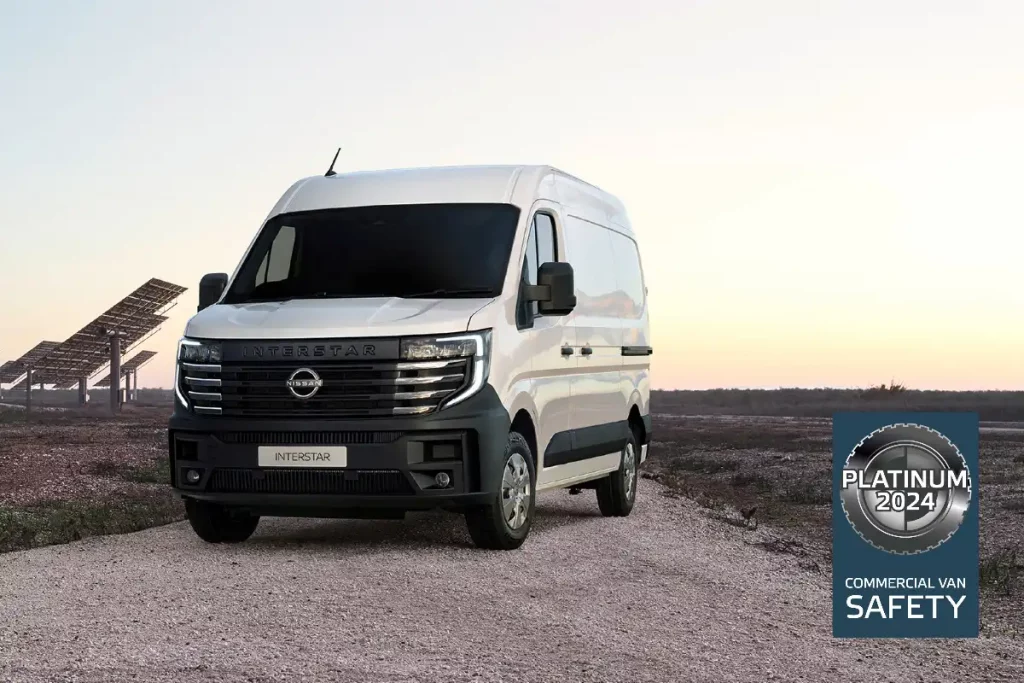
Andrew Limbert, Light Commercial Vehicle (LCV) Manager said: “The outstanding performances across our Light Commercial Vehicle range across all categories demonstrates our clear commitment and dedication to improving passenger and road safety."
"Nissan is at the forefront when it comes to the advanced suite of technologies that act as a second pair of eyes, identifying potential dangers and helping the driver to avoid an accident. EuroNCAP's thorough testing and rating programme, is crucial for consumers to truly understand the various safety technologies we have introduced across our vehicles," he said.
"It’s great to see this recognised across their ratings," Limbert added.
The Nissan range of commercial vans shares platforms with Renault vans. The Nissan Townstar is based on the Renault Kangoo, while the Nissan Primastar shares its platform with the Renault Trafic. All four models are rated as EuroNCAP Gold.
The larger Nissan Interstar van is a sister vehicle to the Renault Master, both vans recorded a platinum rating for their EuroNCAP safety tests.
It's been 70 years since the Volkswagen Transporter first arrived in the UK, making it's public debut at the Commercial Motor Show at Earl's Court, in 1954.
Six generations later, the Transporter is now about to get its seventh generation when it is revealed at the IAA Hannover trade show in September. The newest version will share a platform with the Ford Transit Custom - the first time the VW Transporter has paired up with a partner.
It will get distinctive Volkswagen styling on the inside and out, but will share the same range of engines inlcuding plug-in hybrid and a full battery electric vehicle version.
Since first arriving, the Transporter has sold more than 13 million units across the world and has grown from just 786 UK sales in 1954, to a whopping 17,521 in 2023.
The most recent update was to the Volkswagen Transporter T6.1, launched in 2019, which got a new dashboard, improved connectivity and under went a facelift with updated headlights and grille.
Here's a brief history of the rest of the VW Transporter range.
T1: 1950 to 1967
Revealed as a hand-built panel van prototype in 1949, the T1 eventually launched as a rear-engine panel van, passenger van and eight-seat vehicle. The engine and gearbox came from the Volkswagen Beetle and it offered a maximum payload of 750kg. In 1951, the iconic "Samba" model was revealed with all-round windows and folding sunroof, and a year later a pick-up version was unveiled. Production moved from Wolfsburg to Hanover in 1956, with some models built in Brazil. By 1967, around 1.9 million people had purchased the T1 with its "splittie" windscreen, making it a global success.
T2: 1967 to 1979
With the T1 forging its name as something of a cultural icon during the swinging sixties era, the successor had a lot to live up to. The T2 took the design and utility of the van forward with a new front end and air intake grille. A sliding door was now standard, and the pop-up roof camper version became an instant hit with globetrotters. In 1972, the T2 went electric with a zero-emission version available to buy. During its run, 2.14 million vehicles were built at the Hanover plant. Production continued until 2013 at the Volkswagen plant in Sao Paulo.
T3: 1979 to 1992
The T3 took the famous vehicle into the modern era with a wider body offering, more passenger and cargo space and improved safety. A flat engine, available in diesel, was introduced adding to the spaciousness while a new chassis offered car-like handling. In 1985, a raft of innovations were added: catalytic converters, turbochargers and all-wheel drive, while the California and Caravelle became popular. In total, 1.3 million T3s were made in Hanover.
T4: 1990 to 2003
This generation marked a technical revolution with Volkswagen Commercial Vehicles making the T4 front-engine and front-wheel drive for the first time. With this came a new design, longer front end, new suspension, more varied engine choice and even better handling. The Transporter was also available in two wheelbases for the first time. Following a 1996 mid-model refresh, the T4 was phased out in 2003 having sold 1.9 million models across the range, which had grown to feature the panel van, kombi, double cab, pickup and chassis with single and double cab, Caravelle, Multivan and California.
T5: 2003 to 2015
The T5 was an evolution of exterior design with greater focus placed on the interior and the driver's workplace as well as a variety of petrol and diesel engines and an all-wheel drive system. The California was built in Hanover for the first time, while Caravelle and Multivan continued to be popular choices alongside a number of limited-edition models. In total, 1.65 million T5s were produced.
T6 / T6.1: 2015 to 2019 / 2019 to present
New engines, intelligent driver assistance systems, new infotainment and a front-end redesign have defined the modern T6 era - while the two-tone paint scheme serves as a nod to the original model. In 2019, Volkswagen Commercial Vehicles brought the iconic van into the digital age with a new dashboard design, a raft of technology and connectivity updates as well as a new power steering system and additional efficient, clean turbodiesels.
The UK van segement has seen a mixed performance in the first half of 2024, according to the Society of Motor Manufacturers and Traders (SMMT).
While overall registrations remained positive compared to last year, June marked the end of a 17-month growth streak with a 4.5% decline.
The drop in new van sales is partly due to a strong performance in June 2023, where the industry addressed pent-up demand post-pandemic.
Looking at the full first half, the market is still up 4.5% with over 177,000 new vans, pickups, and 4x4s registered so far this year.
Demand for light commercial vehicles (LCVs) varied across the various segments. Medium sized vans saw a significant rise of 14%, while small vans witnessed an even steeper increase of 58.7%.
However, large vans, which make up two-thirds of the market, experienced an 8.3% drop in registrations. Sales of new pickups and 4x4s also declined in June.
Another area of concern is the decline in battery electric van (BEV) sales.
BEV registrations fell for the third consecutive month, dropping 16.8% compared to June 2023. This brings the year-to-date market share of BEVs down to 4.7%, compared to 5.2% last year. This trend is concerning as under the zero-emission vehicle (ZEV) mandate, manufacturers must ensure at least 10% of their new van registrations are zero-emission this year.
Stellantis continues to dominate the electric van market. Peugeot and Vauxhall models have been the best performing of the Stellantis brands which account for more than 43% of all electric vans sold so far this year.
The Ford Transit Custom continues to be the most popular van model in Britain with 22,139 sales so far. Second is its larger sibling the Ford Transit with 15,983 sales. The Ford Ranger pick-up truck sneaks in as the third most popular commercial vehicle with 10,338 sales, but the third most popular van is the Mercedes-Benz Sprinter with 9,119 sales.